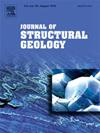Decoding microstructures of fault carbonate rocks with X-ray microtomography: A deep learning approach to fabric classification and analysis
IF 2.9
2区 地球科学
Q2 GEOSCIENCES, MULTIDISCIPLINARY
引用次数: 0
Abstract
Fault zones in carbonate rocks exhibit distinct microstructural fabrics that develop different microstructures with increasing deformation, going from the outer zone towards the fault core. These fabrics can be effectively characterized using X-ray micro-computed tomography (XRμCT), a powerful imaging technique that supports a wide range of analyses, from morphometric measurements (e.g., pore size distribution, fractures orientation) to digital rock physics (i.e., virtual experiments on 3D volumes). However, the need for an automated, user-independent tool to classify these microstructures is crucial for large-scale studies. Furthermore, a fully quantitative classification of fault rock fabrics provides valuable insights into the extent and nature of deformation within these rocks. In this study, we present a deep learning-based supervised neural network designed to automate the classification of fault rock microstructures. This system offers rapid, quantitative, and scalable analysis of XRμCT data, facilitating the identification and classification of fabrics of brittle fault limestone rocks with high precision. The network was trained and validated on purpose collected datasets representing specific fabrics, then it was successfully used on different limestone fault rocks collected from the same area or obtained from the literature. The results show that the software can reliably classify fault rock fabrics affected by brittle deformation into three primary categories, each representing a distinct stage of deformation: fractured limestone, breccia, and cataclasite. The network assigns identification probabilities to each image, which can then be visualized in a ternary diagram for intuitive comparison and interpretation. This classification system streamlines fabric analysis and provides a quantitative measure of the degree of deformation within the rock. This automated classification tool paves the way for advanced studies on the anisotropic properties of fault rocks, enabling high-throughput analysis and enhancing our understanding of fault zone mechanics.
用x射线微层析成像解码断层碳酸盐岩的微观结构:织物分类和分析的深度学习方法
碳酸盐岩断裂带具有明显的微结构组构,随着变形的增大,从外带向断核发育不同的微结构。这些结构可以使用x射线微计算机断层扫描(XRμCT)进行有效表征,这是一种强大的成像技术,支持从形态测量(例如,孔隙大小分布,裂缝方向)到数字岩石物理(例如,在3D体积上的虚拟实验)的广泛分析。然而,需要一种自动化的、独立于用户的工具来对这些微观结构进行分类,这对于大规模研究至关重要。此外,断层岩石组构的完全定量分类为了解这些岩石的变形程度和性质提供了有价值的见解。在这项研究中,我们提出了一种基于深度学习的监督神经网络,用于断层岩石微观结构的自动分类。该系统提供快速、定量、可扩展的XRμCT数据分析,有助于脆性断层灰岩组构的高精度识别和分类。该网络在代表特定结构的数据集上进行训练和验证,然后成功地用于从同一地区收集或从文献中获得的不同灰岩断层岩。结果表明,该软件可以可靠地将受脆性变形影响的断层岩组构分为三大类,每一类代表一个不同的变形阶段:破碎灰岩、角砾岩和碎裂岩。该网络为每个图像分配识别概率,然后可以在三元图中可视化,以便直观的比较和解释。这种分类系统简化了构造分析,并提供了岩石内部变形程度的定量测量。这种自动分类工具为断层岩石各向异性特性的深入研究铺平了道路,实现了高通量分析,增强了我们对断层带力学的理解。
本文章由计算机程序翻译,如有差异,请以英文原文为准。
求助全文
约1分钟内获得全文
求助全文
来源期刊

Journal of Structural Geology
地学-地球科学综合
CiteScore
6.00
自引率
19.40%
发文量
192
审稿时长
15.7 weeks
期刊介绍:
The Journal of Structural Geology publishes process-oriented investigations about structural geology using appropriate combinations of analog and digital field data, seismic reflection data, satellite-derived data, geometric analysis, kinematic analysis, laboratory experiments, computer visualizations, and analogue or numerical modelling on all scales. Contributions are encouraged to draw perspectives from rheology, rock mechanics, geophysics,metamorphism, sedimentology, petroleum geology, economic geology, geodynamics, planetary geology, tectonics and neotectonics to provide a more powerful understanding of deformation processes and systems. Given the visual nature of the discipline, supplementary materials that portray the data and analysis in 3-D or quasi 3-D manners, including the use of videos, and/or graphical abstracts can significantly strengthen the impact of contributions.
 求助内容:
求助内容: 应助结果提醒方式:
应助结果提醒方式:


